Three chapters again today - once I realised what I was reading it seemd a mite daft to stop part way through.
Moses, up on the mountain for a very long time, is receiving detailed instructions for the 'flat pack' temple that is to serve as the centre for religious ritual for the foreseeable future. The level of detail is incredible and allows artists and flim-makers alike to create replicas that almost certainly are a reasonable representation of what is described.
As I read the description of the tent and its frames, a rather mischievous thought came to my head of this as an IKEA product... read the numers of loops and fastenings, pegs and poles and you may see what I mean! Almost more scary is this model making kit than can be purchased.
To what purpose this waste?
The descriptions are incredible - seemingly obscene amounts of precious metals and fine fabrics are to employed to create this tent and its contents. How can this be justified? Surely there are better, more practical uses to which these riches can be employed?
Throughout history people have created vast, ornate, beautiful edifices dedicated to the glory of God. Peasants offering, or having demanded from them, whatever they owned to further the endeavour. And towns and cities vying with one another to have the tallest steeple, the most ornate altarpiece, the finest organ or whatever it may have been.
There is always the risk that beautiful buildings are dedicated "to the glory of NNN and in memory of God" as someone once said to me about a church I was visiting.
And yet... the story of the woman who annointed the feet of Jesus and prompted the question, "to what purpose this waste" always gives me pause. Life is fleeting and fragile, in the medieval period, when many of the great cathedrals were emerging it, was often short and brutal. Maybe this was what people could do... they couldn't read or write, but they could carve stone or wood, could undertake practical tasks to make something beautiful for God. Most of them would never see the end result, but I guess they would die knowing they had contributed to something greater.
I have to confess I struggle with beautiful buildings that seem to suck resources, human and financial, that could be more helpfully employed elsewhere. I do tend to see church premises as 'plant' as something functional, where 'fit for purpose' is the primary aim. And yet... there is something valid and vital about aesthetics... which is why I straighten table cloths, line up hymnbooks, and tweak the layout of chairs!!
One for me to wrestle with, I think.
"From those whose hearts prompt them"
Right at the start of this complex desciption, God asks that "those whose hearts prompt them..." give of their resources for the creation of the Ark, Tabernacle, Altar and associated accoutrements.
This is really important - not a levy, not a tax, not a membership fee or a service charge (though at least some of these will emrge later for other reasons) - a free will offering by those who feel they wish to give.
Experience shows me, both in the Gathering Place and in Dibley, that 'Gift Days' or 'Pledge Days' allow huge levels of generosity to be expressed by those who feel 'led' or 'called' or 'moved' so to do.
Not everyone can give financially, and when we invited pledges a couple of years back, we deliberately included what we termed 'soft pledges' - offers of practical help and prayerful support, offers that were concrete and definable, offers that were nebulous and de facto unmeasureable.
The key was, and is the voluntary nature... which appears in the small print of this section of Exodus.
Graven Images?
When I first moved to Dibley someone asked me, in total seriousness, whether the wooden cross in the porch constituted a graven image. I was a little thrown by this, since throughout most of my life protestant nonconformist churches had proudly boasted about their 'empty crosses.'
The commandments in Exodus 20 prohibit graven images to be made of anything in heaven, on earth or in the waters under the earth, yet now in the plans for the Temple we find golden cherubs, and lamp holders shaped like flowers... what is going on?
The commandment clearly refers to idols - objects made to be venerated in their own right - rather than to decorations. But as I noted above, it is all to easy to slide into situations where servicing the ornament outweighs its original intent.
Early Baptists built plain chapels; by Victorian times geometic and abstract designs had appeared with a lick of gold paint here and there. Nowadays banners and posters, photos and video screens are commonplace. Notwithstanding anything I've already said, I think it's generally a good thing that we have learned to value and enjoy art and creativity rather than maintaining a stark puritanical approach. At the same time, there does seem to be a fine line between valuing, appreciating, enjoying and even 'sanctifying' something and sliding into idolatry or even servitude of that same thing.
The Hebrew people were to create for themselves an amazing Tablernacle, a portable temple that would 'shout' the power and majesty of their God to anyone who cared to see them. The contrast between their own nomadic, peasant existence and the esteem in which they were to hold their God is as challenging today as it was then. Certainly it challenges me to evaluate how I employ the resources entrusted to me.
